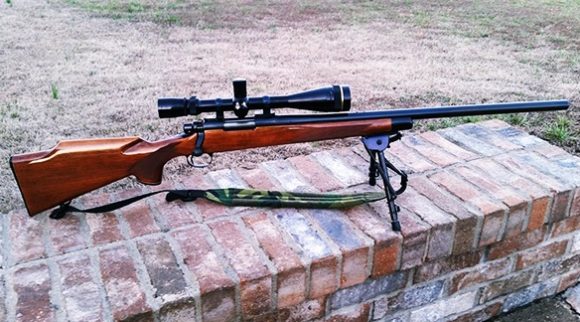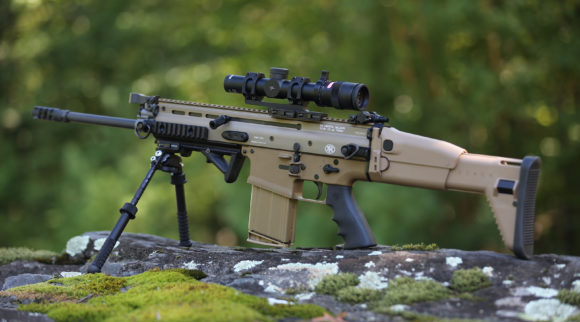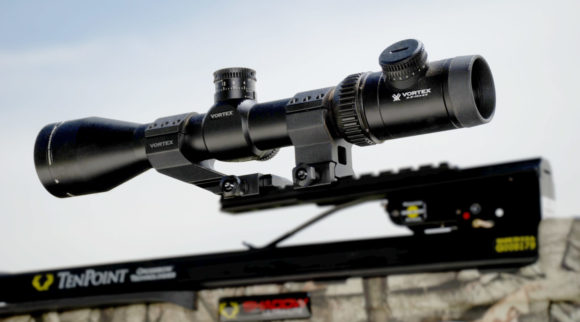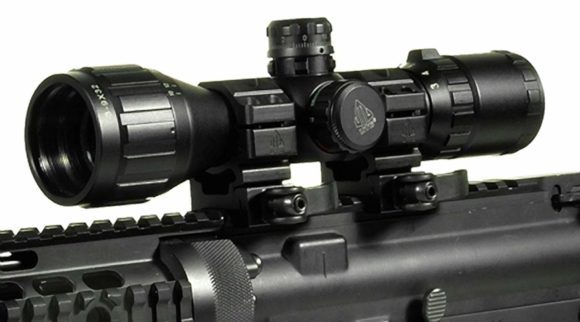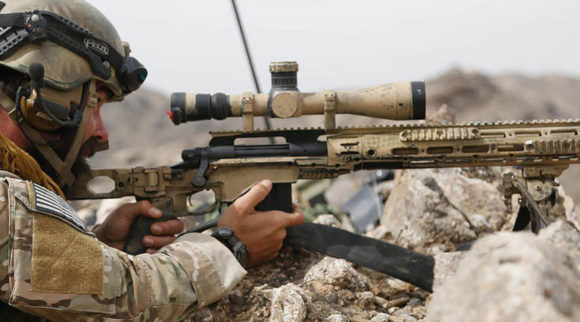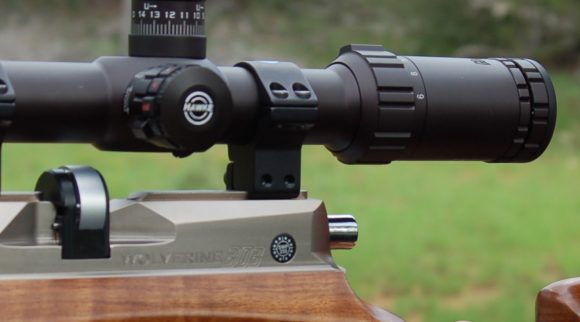Best Scope For 30-30 | Top Rated 30-30 Scopes of 2020

Seeking the best scope for 30-30? Then you’ve come to the right place. Yup, there are a lot of options out there for a .30-30 riflescope and it can definitely be overwhelming. So, rather than letting you become a zombie by falling down the rabbit hole of reading every single customer review out there (don’t worry, we’ve all been there), we made it easy for you. Today we’re going to cover why you need a scope in the first place, what you should consider when choosing the best scope for .30-30, and a few of our top picks for the best 30-30 scopes:
| Ranking | Image | Product | |
|---|---|---|---|
| 1. | Vortex Optics Crossfire II Second Focal Plane | Check Price | |
| 2. | Leupold 171555 VX-6HD 1-6x24 Cdsil CMR2 Tube | Check Price | |
| 3. | Burris 4.5 x-14 x -42mm Fullfield II Ballistic Plex Riflescope | Check Price | |
| 4. | Bushnell Banner Dusk & Dawn Multi-X Reticle Riflescope | Check Price | |
| 5. | Leupold VX-Freedom 450 Bushmaster Riflescope | Check Price | |
| 6. | Vortex Optics Copperhead 4-12x44 Riflescope | Check Price | |
| 7. | Nikon ProStaff 3-9 x 40 Black Matte Riflescope | Check Price |
In this Guide
- Best Scopes for 30-30 Reviewed
- Vortex Optics Crossfire II Second Focal Plane, 1-inch Tube Riflescopes
- Leupold 171555 VX-6HD 1-6×24 Cdsil CMR2 Tube
- Burris 4.5 x-14 x -42mm Fullfield II Ballistic Plex Riflescope
- Bushnell Banner Dusk & Dawn Multi-X Reticle Riflescope with 3.3-Inch Eye Relief, 3-9X 40mm
- Leupold VX-Freedom 450 Bushmaster Riflescope 3-9×40 Matte Duplex
- Vortex Optics Copperhead 4-12×44 Riflescope – Dead-Hold BDC Reticle (MOA)
- Nikon ProStaff 3-9 x 40 Black Matte Riflescope
- Factors to consider when finding the best scope for .30-30
- Mounting Your Scope
- Why you need a quality scope for 30-30
- What to consider
- What is the best scope for .30-30?
Best Scopes for 30-30 Reviewed
Now that you know what to look out for when choosing a scope let’s talk about a few options that might be right for you. Here are seven of our top picks:
Vortex Optics Crossfire II Second Focal Plane, 1-inch Tube Riflescopes
The Crossfire II is a great option for any shooter that wants a scope with excellent quality at an equally excellent price. With this optic you won’t need to worry about breaking or damaging your scope in changing weather conditions due to its high-grade aluminum construction and vast durability. Users have also found that this optic is exceptional in low light conditions as its light transmission is top notch thanks to its use of a multi-coated lens with anti-reflective material.
Check Price on Amazon
Leupold 171555 VX-6HD 1-6×24 Cdsil CMR2 Tube
If you’re looking for a scope with clear and sharp details, great tracking, and one that can stand up to any recoil this is the scope for you. Leupold’s VX-6HD’s custom dial system (CDS) adjusts easily even for inexperienced shooters. It is also paired with a long eye relief, improving the user’s comfort level while allowing to still see a clear picture from edge to edge. This scope also focuses quite quickly allowing the shooter to point and hit their target within seconds without hesitation which is ideal for all hunters.
Check Price on Amazon
Burris 4.5 x-14 x -42mm Fullfield II Ballistic Plex Riflescope
Between the Fullfield II’s crisp and clear details, amazing warranty, and attractive price point you really can’t go wrong with this scope when using .30-30 rounds. Customers have repeatedly said that this is the best bang you can get for your buck as it is easily comparable to higher end brands. Using HiLume multi-coatings on all air to glass lens surface and sealed with quad seals rather than the typical O-ring, the eyepiece on the Fullfield II is practically leak free. Additionally, the placement of this eyepiece is exceptionally forgiving due to its placement and size.
Check Price on Amazon
Bushnell Banner Dusk & Dawn Multi-X Reticle Riflescope with 3.3-Inch Eye Relief, 3-9X 40mm
If you’re new to the hunting game, this Bushnell really can’t be beat. This is easily one of the most popular scopes of the bunch and the friendliest to your wallet with its shockingly affordable price point. But don’t let the price tag fool you. Although this is the least expensive option, it certainly isn’t made cheap. The Dusk & Dawn is fog, shock, and waterproof and well it just really performs like a dream. This one was made to withstand that heavy recoil everyone is so concerned about as long as it is mounted correctly as we mentioned above. Its multi-coated lens is something you see on high performing scopes, which gives it the crystal clear vision that is necessary for low light hunting.
Check Price on Amazon
Leupold VX-Freedom 450 Bushmaster Riflescope 3-9×40 Matte Duplex
In May, 2018 Leupold added six new models to their VX-Freedom line, the Bushmaster Riflescope 3-9×40 being one of them. It does not disappoint. Made in the United States, this Leupold scope uses a 3:1 zoom ratio erector system which performs well in almost any scenario. Although this is one of the more affordable scopes Leupold offers, they were sure to design and test this scope until it met the standards of their top performing optics. The durability and ruggedness of this scope are outstanding, making it one of the top scopes for .30-30, and in general. It is waterproof and fog-proof, you can expect this scope to really last even in harsh conditions. With the 450 Bushmaster’s ¼ MOA adjustments helping to make the most precise shots possible, you can expect dependable and repeatable accuracy with this scope.
Check Price on Amazon
Vortex Optics Copperhead 4-12×44 Riflescope – Dead-Hold BDC Reticle (MOA)
The Copperhead 4-12×44 was made specifically with hunters in mind with its long eye relief, aircraft-grade aluminum tube, and water, fog, and weatherproof build. Since this is meant to hold up in even the harshest weather conditions, the glass is bright, and the reticle is clear in all circumstances including rain and fog. Users will find that the tracking is extremely accurate, performs just like a high-end optic, and cannot be beat for the price.
Check Price on Amazon
Nikon ProStaff 3-9 x 40 Black Matte Riflescope
The Nikon ProStaff is known for dependability and repeatable accuracy. Its positive-click reticle system helps adjustments to be as precise as possible while the quick focus eyepiece makes for a great option for close-range shooters who desire a lightning fast shot. Like every other Nikon this scope is water, fog, and shock proof making it every bit as durable as it is clear in picture with its fully multicoated lenses made with anti-reflective compounds.
Check Price on Amazon
Factors to consider when finding the best scope for .30-30
Earlier we talked about how there are many more factors that go into choosing a scope for .30-30 other than magnification, accuracy, clarity, and durability. After reading these reviews, I’m sure you see what we mean. If you’re still unsure about what features may be most important to you, here’s a breakdown of some other points to think about before making your purchase.
Experience with scopes: Your experience with scopes can determine what type of scope you believe is best for .30-30. If you’re just starting out you’re probably going to want a less expensive option that is intuitive, easy to learn and adjust, and is accurate. While those are all great features to have, for someone with more experience using scopes that may not be the best option. When you’re more experienced you’re going to want something that lets you personalize it with any customizations you may need and has the highest level of quality possible.
Related: Best Scope Under $500
This probably means that price is no longer a big factor for you because you know that using firearms is something you love to do, and it isn’t a hobby you’re going to be forgetting about any time soon. Due to this you know this scope is an investment that is going to pay off. That may also mean you’ll want the most rugged and durable option since it’s going to be used often and kept around for a long time. Your personal experience with scopes is going to be one of those factors that affects the other factors big time.
Price: Needless to say, price is going to be a significant part of the buying decision for most people. I think it’s safe to assume most shooters are going to want to get the most bang for their buck and if they can find a quality scope at a lesser price that would be ideal. But as we know with a higher price tag often comes higher-end features so that may sway some buyers. Typically, more experienced shooters will be the ones opting for the more expensive scopes and vice-versa with less experienced shooters.
Weight and size: Weight and size are important to a lot of people using firearms for obvious reasons. For one, it’s annoying to lug around a massive firearm and scope. It can hurt your arms, sometimes your back, and in general a lighter firearm is going to be preferred by pretty much everyone. But of course, the reason you’re using your firearm will affect how important this point is to you. If you know you’ll be holding your firearm for a long time then this is going to be more of a key component for you but if you’re just a Sunday shooter, having a heavy firearm may not be a big deal for you.
Tube diameter: The diameter of your tube determines how much light you can transmit and how wide your field of view is. When you get a larger tube diameter you will (typically) see that you have more internal adjustments, so they are going to be better for longer-range shooting in most cases. As you size up in tube diameter you will also notice an increase in weight with your scope. If weight is more important than how much light you transmit or vice-versa this may be something to consider.
First or second focal plane: Whether you use a reticle that is positioned in first or second focal plane is entirely up to personal preference but is something to consider when choosing your scope. If you’re not sure what this means, here’s a quick break down. First focal plane (FFP) your reticle will change in size as you zoom; you zoom in, your reticle grows in size, zoom out and your reticle will shrink as your picture shrinks. When using a second focal plane (SFP), which is the more common, your reticle will remain the same size regardless of your zoom. Something to consider here is whether or not you change magnification often. If so, FFP may be preferred.
Objective lens size: Your objective lens size is what affects how much light you are able to gather in your glass. When you have a larger objective lens, you are going to get a brighter and clearer image. This also means the price of your scope will increase as your objective lens size increases. Another factor mentioned earlier to consider is the weight your objective lens bears. When you choose a larger lens size you will also be getting a heavier scope which makes your firearm heavier as well. This is where you’ll need to weigh your options and see which factor is more important in your overall decision.
Reason for use: While this factor is typically more important in buying scopes for other firearms with more diverse uses this could still be on your agenda when choosing a scope. .30-30s are most commonly used for hunting purposes, anything from rabbits to elks but they are very popular for deer hunting. Although this is the most common use there may be others you are considering. What you’re using your firearm for may affect other areas like ruggedness, magnification, and weight and size.
Eye relief: Eye relief is the distance between your eye and the scope in which you can still see the entire reticle clearly. This is important when choosing a scope because it decides how you get to hold your firearm, how you mount your scope to your firearm, and well, it also determines whether or not you get smacked in the face from the recoil of your shot. A good rule of thumb to go by is the more eye relief the better which makes shooting your firearm a safer and more comfortable experience.
Mounting Your Scope
You know you want a scope that helps make all of your shooting dreams a reality but now you’ve got to figure out how you’re going to attach your scope. Choosing the right type of mount and mounting your scope correctly can really make or break your experience with whichever scope you choose.
The mount for your optical is important for a few reasons. The first being eye relief—when a scope is mounted in the right way it’s going to make sure that the position your eye is in when shooting is comfortable and safe. If mounted in the wrong place you may find yourself holding your firearm in awkward positions and possibly putting yourself in danger due to the recoil coming from your shot.
It’s also important that you mount your scope in the right way and securely. If you end up choosing the wrong type of mount for your optic or secure it in the wrong way, you aren’t going to get the most out of your firearm or your scope and again you may put yourself in danger.
You’ll find the one thing that will determine how you mount your scope on your firearm is the way it ejects shells. If you use a Winchester 94 for example, the shells come from the top rather than the side so naturally you’re going to have to position your scope accordingly. The two most popular ways to mount a scope to a rifle using .30-30 is a side mount and a scout set up.
A side mount is exactly what it sounds like, a mount that is attached to the side of your rifle. Unfortunately, a couple issues you may run into with a side mount is that the balance may be off once you add your scope and some notice that their cheek isn’t as close to the gun as they’d prefer when looking through their scope.
The scout set up is another method you can use to attach a scope to a rifle using .30-30. When using a scout set up, the shooter will purchase gas tubes with attached picatinny rails or handrails and use them to attach their optics with. It’s a more DIY version of mounting your optic but it works just the same.
Why you need a quality scope for 30-30
Your need for a scope will be unique to everyone else’s. While scopes are ordinarily used to improve a long-range shot, when using .30-30, long-range isn’t what initially comes to mind. The .30-30 cartridge performs best for short and medium range shots and a great scope can up-level even the most low-quality rifle if chosen correctly.
See Top Article: Best Rifle Scope
While you may not be using your scope for long-range needs, the same reasons for buying a scope still apply. Shooting a rifle without an optic can be difficult and will usually end in inaccuracy. A scope is almost always going to improve your precision when shooting by magnifying your view and allowing you to line up your shot with your target helping you to achieve repeatable and dependable accuracy.
What to consider
Before going into our top picks .30-30 scope we should talk about what to consider so you can make the best decision for your needs. There are many factors that can go into choosing a scope but the weight of these factors is going to vary from person to person.
Moreover, you’ll find that some of these factors affect the others. For example, the price point of your optic may be a big factor for you if you’re just starting out and don’t want to make a huge investment. What that means is that maybe you’re going to want to settle in some areas like getting a smaller tube size and a smaller objective lens for your scope since those typically add to the price tag.
Unfortunately, larger tube and objective lens sizes add to the quality of your experience with your scope, so you’d have to compromise a little in that area. Likewise, if weight is a factor that is important to you you’d want to make a trade off in some areas even though your scope may not be as high performing afterward.
So, you see there are some things that will affect the other factors and there may be some areas you’ll need to settle with in order to find that perfect scope for you. That’s where it gets tricky to suggest one or even a few scopes that would be ideal for most shooters since everyone has their own preferences. As mentioned, there are a lot of factors that will go into your choice (more on that later) but right now let’s focus on four main categories: magnification, accuracy, clarity, and durability.
Accuracy
There are many factors to consider here but accuracy should be the first on the list. A scope’s sole purpose is to make sure you’re able to zero in on that target and improve accuracy, precision, and predictability. If accuracy is lost in a scope, then there is no reason to have a scope at all. The goal when choosing a scope is to get one that can give you the most accuracy possible.
Related: Best Scope for AK47
Clarity
This is a huge thing to consider when looking for a scope because without it, your scope is nearly useless. Clarity is going to be what dictates how clear the picture of your scope is. This affects how well you can see your reticle as well as the actual target. When your clarity is high, you’re going to notice that your shots are more exact, and you’ll have a record of more error-free shots.
Magnification
The magnification capabilities of your scope should be one of the top characteristics you consider. While there are many details about your scope that weigh in on your decision, magnification should have a great deal of importance since it has a direct effect on your accuracy. When using a .30-30 round you are likely going to be shooting in closer proximity, meaning a high magnification may not be ideal. Lower magnification will help you to still be able to see the “bigger picture” while finding your target.
Related: Best Thermal Scope
Durability
Durability is important in buying a scope for your firearm because you’re going to want it to last. Firearms can take quite the beating between getting dropped, general use, and being subjected to harsh weather conditions. Whether you’re just starting out or you’ve been using firearms for quite some time you know that this isn’t a cheap hobby to pick up. That’s why when you purchase something like a scope you want the ruggedness and the durability to be as high as possible so that you can use your scope for a long as possible and get your money’s worth out of it.
What is the best scope for .30-30?
Now that you know how to mount your scope and what your options are you may be wondering which the scope is right for you is. There really isn’t one that wins out over the others and that’s because the right scope for you is going to rely entirely on your own circumstances. What is good for you may not be good for your buddy or the shooter to your left. We all have our reasons for wanting to use a scope while using .30-30.
Related: Best Scope Under $1000
New shooters may want to start out with Bushnell’s Dusk & Dawn due to the low price point. On the other hand, they may be new but want to invest in a high-end scope right away if they have a buy o!nce, cry once mentality. There’s really no single scope that will adhere to every single shooter’s needs.
The best thing you can do when choosing a scope is consider your conditions, what you’re going to be using the scope for the most, and what factors are the most important for your personal uses. Then, make an informed decision by reading reviews like this one and make sure not to get caught up in the hype of what is “the best on the market” or what the professionals may be using. After all, a scope is only as good as the shooter using it so be sure that whatever choice you make is the one that is right for you. Happy hunting (online and on the ground)!


